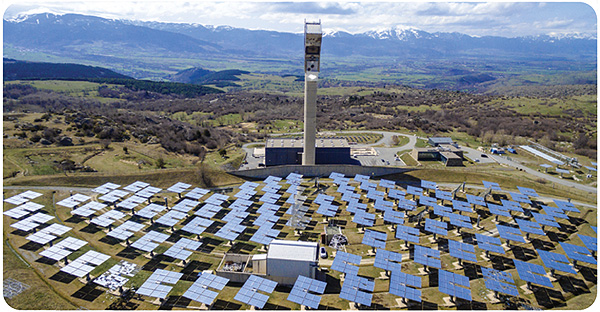The POLYPHEM project aims at improving the flexibility and the performance
of small-scale Concentrated Solar Power plants, thanks to a solar-driven micro
gas-turbine technology. As a final result, the project is building a 60kW prototype
plant with a thermal storage unit and will validate this innovative power cycle in a
relevant environment at the Themis solar tower in Targassone.
The challenge for small-scale CSP Plants
The decentralized generation of
power on-demand in remote areas at
competitive cost is a major challenge
of CSP to which POLYPHEM is all about. This project
of small-scale solar tower proposes
robust technologies of engines
forming the combined cycle (micro
gas-turbine and ORC), easy-handling
heat transfer fluid (thermal oil) and
cheap material for heat storage
(concrete). One expectation of this
challenging project is to demonstrate
the reliability of the technology and
the flexibility of the power generation
from solar energy.
POLYPHEM: Small-Scale Solar Thermal Combined Cycle
Funded under Horizon 2020
(Energy programme), POLYPHEM is
coordinated by CNRS-PROMES and
brings together 9 partners from 4 EU
countries. The project runs from April
2018 to March 2022 with a 4.975 M€
EC grant over these 4 years.
The main objective of the POLYPHEM
project is to improve:
- the performance of small-scale Concentrated Solar Power (CSP) plants
- and their flexibility to generate power on demand
To this end, a new technology is
proposed: a solar-driven combined
cycle with integrated thermal energy
storage.
The power block considered in
POLYPHEM is a combined cycle
intended to be used for decentralized
small-scale power generation in the
range 40 kW to 2000 kW in remote
areas. The purpose is to meet the
variable demand of energy of a minigrid.
The baseline technology consists
of an air Brayton cycle as top cycle
and an Organic Rankine Cycle (ORC)
as bottom cycle.
POLYPHEM broadens this technology
by driving the top cycle with solar
energy through the development
of an advanced technology of
pressurized air solar receiver and
by including an innovative thermal
energy storage unit between both
cycles. Besides electricity generation,
other applications will be considered
for future developments.
Expected impacts and results
The outcomes of POLYPHEM will
allow in the short term to reinforce
the competitiveness of this new low
carbon energy technology, to favour its
integration in the medium term in the
European energy mix and to contribute
to the mitigation of climate change.
The main expected impact of
this project is to enhance the
competitiveness of low-carbon
energy production systems through
the technology developed. The
expected progress is a better fitting
of electricity generation to variable
local needs, an overall conversion
efficiency of solar energy into
electricity of 18% for an investment
cost of less than 5 €/W and a low
environmental impact.
By 2030, the cost of electricity
production targeted by the POLYPHEM
technology is 165 €/MWh for an
annual direct normal irradiation of
2600 kWh/m2/year (North Africa and
Middle East) and 209 €/MWh under
2050 kWh/m2/year (Southern Europe).
In addition to decentralized power
generation, other applications are
considered for the deployment of this
technology used in poly-generation:
solar heating and cooling of multifamily
buildings, water desalination
for small communities, industrial heat
production, desalination of seawater
or brackish water, etc.

More information
Wesbite: https://www.polyphem-project.eu/
This project has received funding from the European Union's Horizon 2020 research and innovation programme under grant agreement N° 764048.